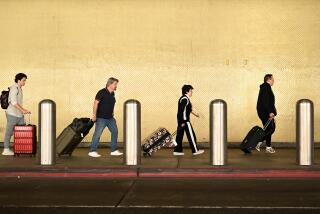Preparation Can Minimize Risk of Injury During Travel
- Share via
For many people traveling this holiday season, the most painful experiences will come in the form of longer lines at airports and more crowded roads. For some, however, the pain will be physical--the result of injuries and illnesses acquired in the course of their travels. As any doctor who treats these problems can tell you, many of the travelers’ illnesses and injuries can be avoided.
Some common but avoidable problems include: flare-ups of chronic diseases (because people forgot to bring their drugs or ran out of medication during their trip); serious infectious diseases (because needed immunizations were skipped); complications caused by medical mistreatment (because travelers didn’t know how to find a competent doctor); and--the most common cause of serious travel-related medical problems--injuries from auto and pedestrian accidents (because of unfamiliarity with local conditions or due to alcohol or drug consumption).
Although there is no way to guarantee you’ll remain healthy when traveling, a little advance preparation can minimize the risk that illness or injury will ruin your trip or permanently damage your health. If you have any medical problems, touch base with your physician before you leave. If your medical problems are complicated, ask the doctor for a brief summary of your medical history, including your immunization record and a complete list of all the drugs you are using (including the recommended dosage). Keep the summary with you throughout the trip.
Whenever you travel, always carry a medical kit that includes an adequate supply of the prescription and nonprescription medications you use regularly or occasionally. Even a long-standing condition--like high blood pressure or an underactive thyroid--can become problematic (even life-threatening) if you forget to bring your medications or run out of them during your trip (it can be very difficult to get them replaced or refilled in some locations--especially at night or on weekends).
Your kit should also include such things as antiseptic solution and adhesive bandages; nonprescription medications such as acetaminophen, ibuprofen or aspirin to deal with pain or fever; cortisone cream to treat skin irritation; and antihistamines to manage mild allergic reactions. (If traveling with children, bring both adult and pediatric formulations of medications.)
If you are traveling by plane, train or bus, carry the medical kit on board with you, so if your baggage is lost, your medications won’t be. If space is a problem, carry your list of medications and enough medication for two days on your person, and put the rest in your checked baggage.
If you will be traveling to a foreign country, check with your doctor or a specialized travel clinic to see if you need any immunizations or prophylactic medications (for example, antibiotics to protect against malaria if you are traveling to an area where this disease is endemic).
Also, pay a visit to the travel Web site maintained by the Centers for Disease Control and Prevention (www.cdc.gov/travel). The site provides referral lists to qualified travel clinics, country-by-country immunization recommendations and up-to-date information about disease outbreaks (for example, polio is currently a problem in the Dominican Republic, and immunization is advised). Wherever your travels take you, it’s a good idea to study your current medical insurance policy carefully before you leave to see what special conditions apply when you are away from home and to learn what you must do to protect your benefits. You may, for example, need to contact your insurance carrier for prior approval of treatment if you seek medical attention. And, of course, don’t forget to bring all of your insurance information with you, particularly proof of coverage. (If you do receive medical care, get full written documentation of what was done and your costs.)
If you are traveling to a foreign country, give serious consideration to purchasing a special policy to protect yourself against catastrophic expenses. This type of travel insurance is an especially good idea if you are elderly, suffer from a chronic medical condition or are traveling to a high-risk area (a malaria zone, for example). The benefits offered under these policies vary widely, so read the fine print carefully before enrolling. Many policies will reimburse you for nonrefundable trip expenses if you have to return home earlier than planned; others go so far as to cover the cost of emergency medical evacuation back to the United States if you are hospitalized in another country. Policy costs vary according to the benefits offered and the age of the person seeking insurance; typical fees for trips under 30 days in duration range from $40 to $100.
A few simple steps will reduce the chances that you will ever need to collect on these policies. Whether local regulations require a seat belt or not, always buckle up whenever you’re in a moving vehicle (including taxicabs and buses), and don’t let your children ride without being properly restrained. If you are trying to pare back on luggage, leave something other than the car seat behind or find a way to rent one at your destination (most rental car companies make them available to customers).
On driving trips, look at a map and plot out your course before you get into the car so you can focus on the road when you’re driving. Also, set reasonable goals about how much distance you will cover and avoid driving too long at one stretch. If more than one person is available to drive, take turns behind the wheel; if you’re the only driver, pull off the road for regular breaks. Finally, if you’ll be driving in a foreign country, be sure to familiarize yourself with the driving laws there.
Whether driving or flying, avoid sitting still for too long to prevent the problem of deep vein thrombosis. Potentially dangerous blood clots can develop in veins deep inside the leg when you remain immobile for too long. When driving, stop often and get out of the car for a short walk. When flying, bend and straighten your legs, feet and toes every half-hour or so while you are seated and take occasional short walks when it is permissible and safe.
And, finally, don’t let the long lines and crowds get to you. Take a few deep breaths and relax. You’re on vacation after all.
Dr. Jonathan Fielding is the director of public health and the health officer for the Los Angeles County Department of Health Services. Dr. Valerie Ulene is a board-certified specialist in preventive medicine practicing in Los Angeles. Send questions by e-mail to: our health@dhs.co.la.ca.us. Their column appears the second and fourth Mondays of the month.
More to Read
Sign up for The Wild
We’ll help you find the best places to hike, bike and run, as well as the perfect silent spots for meditation and yoga.
You may occasionally receive promotional content from the Los Angeles Times.






